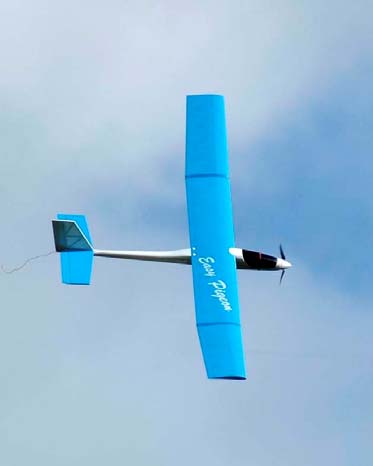

 Easy Pigeon
Easy PigeonThe Easy Pigeon has served me well this summer and I thought a few words on the plane might not go amiss. As most will know it is an ARTF glider distributed by Perkins, although I'm not sure who makes it. It is fairly popular and seems to be stocked by most online shops.
The Pigeon is exactly the same model as the BMI Montana (different colour scheme), although that appears to be scarce on the shelves nowadays.
Well, after spending £55 you can expect to find a blow moulded fuselage, a three piece wing and a set of tail feathers. A 600 brushed motor, complete with spinner and 8 x 4½ folding prop and pushrods for the elevator and rudder are already installed. To complete the stock set up, two standard servos and a 30 Amp speed controller are required along with a 6 cell NiMh. The Pigeon will fly very happily on this set up and a few lifts will be obtained from a full battery. Climb rate is slow though, but good enough to begin with as I did.
The 72 " wing comes in three parts and is bolted on to the fus with nylon bolts. The wing can either be glued into a one piece or retained as a three with the outer tips taped on for flight. The wing and tail is of conventional built up construction with good sturdy covering applied.
My current Pigeon is my second; my first went through all the pain whilst I mastered the art of keeping it in the air and suffered a few blows in the process proving its all round sturdiness However, that model has been patched up and is still in service as my hack sloper. Come to think of it I only have hack slopers.
Anyway, my second Pigeon got the Findlay upgrade pack and out went the brushed set up. I have installed an EnErG 3650 brushless inrunner (1000kv) turning a 9 x 6 prop off a 3S Lipo through a 40 Amp ESC.
I also opted for SD200 servos which, being smaller save some weight, but to balance it I required almost 6oz of lead up by the motor. The AUW is 1.2kg which is about 100g lighter than the stock set up. This made for a stable aircraft, however the lead has now been removed and the battery brought forward to make it lighter. It is more sensitive as a result as the CoG is slightly more towards the tail, but I'll settle for that in the hope of better floatability.
The difference in performance under the brushless configuration is like night and day. A 30 second motor burn will comfortably get you up to the 700 feet mark and I can expect about 8 - 10 good lifts from my 2200 pack.
In flight the plane is stable with little vices. As with most gliders, a good dad of down needs to be applied under power, but on the glide it is quite slow and holds the air well, although I would not describe it as a floater per se.
In a thermal, it can rise with the best of them and is the model that returned my 42 odd minute flight in August.
As I said my first Pigeon suffered some hefty blows and the fuz twists and crumples itself up on impact. Application of a heat gun or immersion in boiling water softens the plastic stuff and it self straightens to a degree. A bit of gentle persuasion to hold it whilst it cools and you would hardly know it had been in a bump. The wing is strong and being wood is easy to repair should you stand on it for example !!
My only complaint about the Pigeon is the canopy which is held on by little black screws and needs to be removed to effect battery changes. There must be a good box of these screws lying in Calder Park by now! I eventually got roun to installing a piano wire catch system that makes life easier.
All in all a good little model for the money and one that gives plenty of enjoyment beyond the beginner.